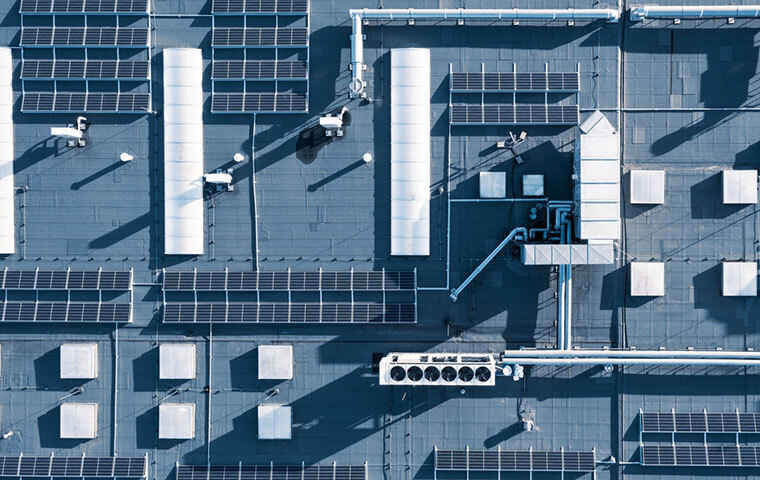 Federal buildings are a major source of the U.S. Government’s direct greenhouse gas (GHG) emissions. Image: Vladyslav Horoshevych/Shutterstock.com
By: FEDweek Staff
Federal buildings are a major source of the U.S. Government’s direct greenhouse gas (GHG) emissions. Image: Vladyslav Horoshevych/Shutterstock.com
By: FEDweek StaffFollowing are key sections of a fact sheet issued by the White House in conjunction with an announcement of new energy standards for current and new federal buildings.
In the United States, residential and commercial buildings represent 35 percent of carbon dioxide emissions. Commercial and government buildings cost $190 billion to power each year. With eighty percent of all existing U.S. buildings expected to remain in service in 2050, electrifying existing buildings is essential to achieving President Biden’s climate goals.
Council on Environmental Quality Announces First-Ever Building Performance Standard for Existing Federal Buildings
The Council on Environmental Quality’s (CEQ) Federal Building Performance Standard requires agencies to cut energy use and electrify equipment and appliances to achieve zero scope 1 emissions in 30 percent of their buildings by square footage by 2030. To reach that mark, agencies will be buying American-made products such as heat pumps, electric water heaters, and other energy efficiency and building system technologies supported by the Inflation Reduction Act.
Federal buildings are a major source of the U.S. Government’s direct greenhouse gas (GHG) emissions. Energy used in Federal buildings for space heating, water heating, cooking, and other needs account for over 25 percent of Federal emissions. In addition to lowering costs, efficient electrification of building equipment and appliances reduces air pollution — [thus] improving health in workplaces and communities.
Upgrading the Federal building portfolio to meet the new standard will reduce reliance on imported fossil fuels from volatile parts of the world and cut millions of tons of GHG emissions. Funding provided through the President’s Bipartisan Infrastructure Law, agency operating budgets, and the Climate Smart Buildings Initiative will aid implementation. To further reduce costs and maximize efficiencies, agencies will apply electrification strategies in conjunction with deep energy retrofits, energy use and water use reductions, and other facility improvements.
New Energy Standards for Federal Buildings Will Spur Renovations, Says White House
Today DOE released a Supplemental Notice of Proposed Rulemaking seeking public comment on a forthcoming rule, Clean Energy for New Federal Buildings and Major Renovations of Federal Buildings, to support building decarbonization. The rule would set emissions reduction targets and require equipment and appliance electrification in new Federal buildings as well as Federal buildings undertaking major renovations. The rule is projected to save $8 million per year in building costs. The Federal Building Performance Standard and the rule work together to ensure a comprehensive approach to Federal building decarbonization while reinforcing the urgency to reduce GHG emissions and creating new markets and well-paying jobs.
Agencies Are Taking Action Now to Cut Building Energy Use and Emissions
In response to the President’s early executive orders and Federal sustainability goals, Federal agencies are advancing net-zero goals across new building construction, major modernizations, and existing building retrofits—electrifying systems, saving energy, and lowering emissions. Highlights include:
Last month the General Services Administration (GSA) announced that it will not use Inflation Reduction Act funding to install fossil fuel-based equipment, a commitment that reaffirms the Federal Government’s commitment to building electrification.
In 2023, GSA will open the Des Moines U.S. Courthouse, a new all-electric, energy-efficient Federal courthouse for the Southern District of Iowa that features a highly reflective cool roof, insulated windows, and LED lighting. Next year GSA also will complete the modernization of the Denver Federal Center Building 48, an existing vacant warehouse that will be converted into an efficient, all-electric 150,000-square foot office space for the Department of the Interior. Modernizing this existing building will minimize embodied carbon emissions, and it will be designed and operated to achieve net zero carbon emissions.
Earlier this year DOE announced a $38 million Net Zero Labs (NZL) Pilot Initiative to decarbonize four national laboratories and lay the foundation to address hard-to-decarbonize industries. The Initiative will demonstrate solutions that can be replicated at facilities across DOE, state and local governments, and the Federal Government. Project examples from this initiative that will meet the new Federal Building Performance Standard include:
By 2023, DOE’s National Renewable Energy Laboratory (NREL) will eliminate the use of gas at its Flatirons Campus by converting four existing facilities to electric heating. Further, NREL aims to eliminate the use of gas for heating and switch to a carbon-free district heating and cooling system at its South Table Campus by 2027.
In 2021, DOE’s Pacific Northwest National Laboratory (PNNL) began a replacement project to upgrade a gas-fired boiler and steam system at Battelle Inhalation Lab with two efficient electric boilers. Additionally, in 2023, PNNL will replace aging gas-fired steam systems that support four buildings with new high efficiency electric systems. These conversions will improve facility reliability and increase energy efficiency, yielding significant cost savings and reducing GHG emissions.
Spending Bill Allows 4.6 Percent Raise by Default; Doesn’t Prevent a Future Schedule F
Some TSP Features among Many Policies Affected by Spending Bill
Most Expansion of GS Localities Put Off Until 2024; 2023 Raises to Be Announced Soon
Pay Agent Repeats Criticisms of Federal Pay-Setting Process
MSPB: Sexual Harassment in Federal Agencies Unacceptably High
Survey Finds Lack of Confidence in Channels for Reporting Harassment
Report Cautions Federal Employees on Recruiting Friends, Family
No Snow Days for You, OPM Reminds Offsite Workers
Extra Time Off around Christmas Holiday Unlikely This Year
See also,
The Process of Retiring: Last-Minute Changes
The Process of Retiring: Check Your Agency’s Work
FERS Retirement Planning Bundle: 2022 FERS Guide & TSP Handbook

